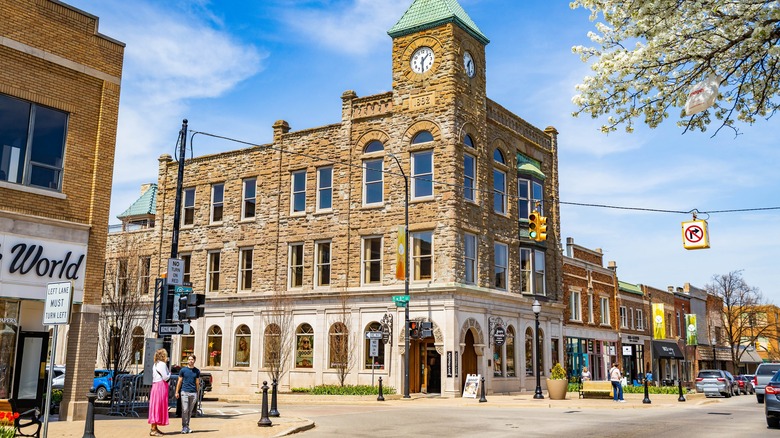Michigan's 'Tulip City' Is A Vibrant, European-Style Destination Full Of Dutch Charm
With its cobblestone sidewalks, authentic windmill, and millions of colorful tulips that bloom every spring, Holland, Michigan, is a lovely American city that feels like a European destination. Even its name sounds distinctly Dutch. But the city, appropriately nicknamed "the Tulip City", is far from the Netherlands geographically. The land around Lake Macatawa, near the eastern shore of Lake Michigan, was originally the home of the Odawa people. In 1847, a group of Dutch Calvinist separatists, who were seeking religious freedom, founded Holland on the southeastern shore of the lake. They started incorporating Dutch culture and traditions into their new Midwestern lives, which visitors can find plenty of evidence of today. The city's festivals, parks, and even restaurants still have an undeniably Dutch vibe.
Holland is only 30 miles southwest of Grand Rapids, considered America's beer city. Gerald R. Ford International Airport (GRR) receives nonstop flights throughout the United States. From Grand Rapids, you can either rent a car or take an Amtrak train. It is less than an hour from the Vernon J. Ehlers Station to Holland on the Pere Marquette line. The same train then continues along Lake Michigan's southern shore, eventually reaching Chicago almost three-and-a-half hours later. Expect views of blueberry fields and the lake along the way.
Things to do in Holland, Michigan
When you arrive in Holland, Michigan, you'll immediately feel like you've been transported to the Netherlands. Cobblestones and brick buildings line downtown, built at the turn of the century after a large forest fire destroyed most of Holland in 1871. Built with stronger materials, these buildings are part of the Holland Downtown Historic District, which has been listed on the National Register of Historic Places since 1990.
These historic buildings are now filled with boutiques, cafes, and galleries where visitors can experience the area's Dutch culture. Nelis' Dutch Village Downtown sells Dutch cheeses and wooden shoes, while DeBoer's Bakkerij, a fourth-generation bakery, makes traditional Dutch currant bread and buns. Meanwhile, the Dutch Galleries display gifts of Dutch culture at the Holland Museum.
It seems like there's always something to do in Holland. A heated snowmelt system keeps the city's cobblestones clear all winter, which means you can explore at any time of year. Fall Fest means pumpkin carvings and hayrides, while the European-style holiday market, Kerstmarkt, and Holland on Ice, an ice sculpting event, are fun winter activities. The award-winning farmers market, Summer Street Performer Series, and the Summer Concert Series create festive atmospheres as the weather warms up. But perhaps the largest event of the year is the annual Tulip Time Festival. Started in 1929, visitors can take part in activities, events, and parades for 10 days in May. Its beautiful tulips draw hundreds of thousands of visitors to Holland each year, making it one of the best spring vacations in America.
Dutch landmarks to visit in Holland, Michigan
Downtown Holland isn't the only place to experience Dutch culture. Windmill Island Gardens has the only authentic Dutch windmill operating in the country. This seasonal, 36-acre park (adults $12) was created to preserve Holland's Dutch heritage. The city added an antique Dutch carousel and canals and even purchased De Zwaan (the Swan), a windmill built in the Netherlands in 1761. In 1964, it became the last working windmill allowed to leave the European country.
Nelis' Dutch Village lies north of Windmill Island Gardens. Visitors can step back in time in this 19th-century-inspired Dutch village. You'll find Dutch architecture, canals, and dancers in traditional wooden shoes. Kids will enjoy the petting zoo and the rides, while at the Hungry Dutchman Cafe you can try Dutch specialties like erwtensoep and banket.
After stocking up on Dutch treats, you should also visit the Holland Harbor Lighthouse. The original Dutch settlers first built a lighthouse at the entrance to the channel where Lake Michigan and Macatawa meet in 1870. The current structure, affectionately called Big Red, replaced it in 1907. It's now the most photographed lighthouse in Michigan.


